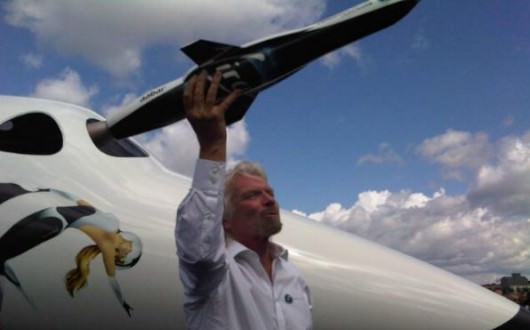Caption: Richard Branson at the Farnborough International Airshow showing a model of LauncherOne. Credit: Virgin Galactic.
Virgin Galactic’s latest venture is launching small satellites with a new, more affordable launching system called LauncherOne. “The pieces are all in place to transform the business of satellite launch, which will open up space to everyone,” said the founder of Virgin Galactic, Richard Branson. “This new vehicle will change the whole satellite industry and space-based science research.”
LauncherOne is much like the Pegasus system, operated by Orbital Sciences Corporation, which launches a rocket from an aircraft, as was done with NASA’s NuSTAR X-ray observatory. LauncherOne will be attached to the WhiteKnight plane, the mothership for SpaceShipTwo, Virgin’s commercial suborbital passenger ship.
LauncherOne could be used for smaller Earth observation and communications satellites.
Virgin Galactic has hinted previously that they were working on a rocket to put spacecraft into orbit, but they have been focusing on SpaceShipTwo. Branson announced the new launcher at the Farnborough International Airshow in the UK today.
“Small satellite launch is an area ripe for disruption,” said Virgin Galactic CEO George Whitesides. “Miniaturized satellite components and constrained budgets are driving commercial clients, academic users and government agencies all to clamor for an affordable, dedicated launch vehicle. Now,…we’re prepared to fill that void by bringing LauncherOne to market.”
Initial information about LauncherOne is that it would use a two-stage rocket powered by liquid oxygen and kerosene.
It would be capable of launching payloads of up 225kg (500lb) into low-Earth orbits, and for a price below $10 million.
“The cost of putting a satellite into space before Virgin Galactic was around $30-40 million,” Branson said. “We’ll be able to do it for under $10 million, opening up space to thousands of new groups, universities and research programs.”
LauncherOne will be built in California, with test flights starting in 2015 and commercial operations starting in 2016.
“Virgin Galactic’s goal is to revolutionize the way we get to space,” Branson said. “I’m immensely proud of what we have already achieved as we draw near to regular suborbital flights on SpaceShipTwo. Now, LauncherOne is bringing the price of satellite launch into the realm of affordability for innovators everywhere, from start-ups and schools to established companies and national space agencies. It will be a critical new tool for the global research community, enabling us all to learn about our home planet more quickly and affordably.”
Branson said he already has people lined up to book the new launcher. “Even before this official launch we have the largest order book of any new launch vehicle ever,” he said on the Virgin blog.


And how many X-37 derivatives and ‘radar pods’ has the White Knight flown? The X-37 was first flown June 21, 2005, and the first drop test was on April 7, 2006. Shhhh… be wary wary kwiet when you close that hanger door…. It IS 3 o’clock in the morning!
the price should be less than $5 million to attract more customers
Well the lower the better, but they intend to make a profit.
This is a publicity stunt. Why would customers pay $10 mil for 225kg when they can launch over 1 ton at SpaceX for the same price?!
But thats the big positive thing about this. Competition will drive
prices down, down, down. Eventually if SpaceX does it cheaper, Virgin
will find ways to bring cost down and it will cause SpaceX to go down to
keep pace. Hopefully even more companies get into the market to make
the price wars happen sooner. Notice how the price wars already started
when it says in the article the Virgin was charging $30 mil.. Now they
are down to $10 mil… By 2025 I’ll but its under $1 mil.
“…under $10 million…”
There is something I hate about that company. Cheap publicity for general public without explaining and even mentioning key definitions and technological concepts. Space tourism, going to space, future astronauts… yes, there is place for that business. But their mach 3 flight, just above Kármán’s line, hardly qualifies as space flight and has nothing at all in common with orbital flight.
Now. LauncherOne. Is it reusable? Is it really cheap? To compare to what? It would be totally wrong to claim that guys at Virgin Galactic has not achieved anything. In fact, they have achieved a lot. But sometimes I feel that they are better at selling themselves, than going to space.
Suborbital space qualifies to keep physicists and US astronauts happy, and it will make many space tourists happy.
Pegasus launch cost 1994 was 11 MUSD, in todays USD ~ 13 M, @ ~ 440 kg LEO payload [Wp]. SpaceX can orbit small payloads from the trunk during future large scale satellite and DragonLab missions.
I do think Virgin has a market to diversify in, it is a way to reduce the WhiteKnight carrier cost, I doubt they are that much more competitive. Of course, future development with reusable SSII technology (1st stage) or as a SSIII orbital forerunner could also be part of this.